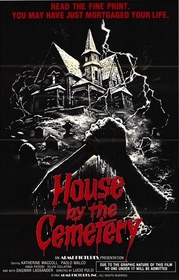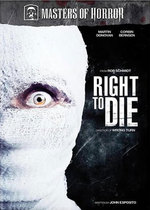Our editor-in-chief Nate Yapp is proud to have contributed to the new book Hidden Horror: A Celebration of 101 Underrated and Overlooked Fright Flicks, edited by Aaron Christensen. Another contributors include Anthony Timpone, B.J. Colangelo, Dave Alexander, Classic-Horror.com's own Robert C. Ring and John W. Bowen. Pick up a copy today from Amazon.com!
House by the Cemetery (1981)
Lucio Fulci’s The House by the Cemetery is difficult to evaluate. As the last installment in Fulci’s classic zombie quartet (preceded by Zombie, City of the Living Dead, and The Beyond), House reviews range from excellent to horrible. Defying simple classification, the film could easily fall into any of these horror subgenres: zombies, haunted houses, supernatural thrillers, mad scientists, or slashers. At times splendidly nightmarish, and at others downright annoying and hilarious, House will tantalize horror aficionados but disappoint most causal viewers.
In Boston’s suburbs, psychiatrist Dr. Normal Boyle (Paolo Malco) continues the research of Dr. Steve Peterson, who was studying suicides before he hung himself and killed his mistress. Boyle brings his family to Massachusetts after convincing his wife, Lucy (Katherine MacColl), that the move is a six-month vacation in New England. When the Boyles select a spooky house next to a cemetery, which was Peterson’s former abode, ominous signs surface: besides creaking doors, oddball sounds, spider webs, and isolation, this house hosts an unfriendly bat, tombstones under the floor, and Dr. Freudstein, a 19th century physician notorious for conducting illegal experiments.
Their son, Bob, like Danny in The Shining, has an undetected ability to “see” the apparition of Freudstein’s daughter, who tries to warn Bob of impending horror. Bob’s nanny, Ann (Ania Pieroni), also possesses a supernatural aura. As Boyle learns, Peterson mysteriously ended his research after discovering and investigating Freudstein and the mad doctor’s experiments. When Boyle foolishly leaves his wife and child behind to travel to New York, Freudstein, who also inhabited this house and is currently living in the basement, goes to work; part zombie, part Frankenstein’s monster, Freudstein survives on human flesh... not exactly what the Boyles wanted to discover!
True to Fulci form, the film is horror exploitation at its best, and plenty of blood, gore, impalements, decapitations, and maggots serve as evidence. However, House also qualifies, at least accidentally, as a splat-stick. Although the humor is unintentional, House produces as many laughs as nightmares. The way-too-long bat scene is perfect for Mystery Science Theater 3000, and the unfortunate ending for the mannequin in the store window is equally ridiculous. Boyle’s explanations to Lucy justifying a vacation near a cemetery and for discovering tombstones under floorboards offer plenty of chuckles, and young Bob should never be taken seriously, as his acting coach must have been deaf and blind. And the name of Freudstein? Let’s not even go there.
Prior releases on VHS and DVD have a sordid history of mistakes and problems, and most critics agree Anchor Bay’s 2001 release is the best. However, the dubbing will still drive viewers mad, especially since it further ruins young Bob’s already over-the-top performance. Some have called Walter Rizzati’s score effective; I don’t. The stuffy, melodramatic chords and riffs reminded me of a Genesis concert on acid: during several scenes, I was waiting for keyboardist Tony Banks to kick into “Abacab” or “Turn It on Again”. I should have been getting scared.
Too many key elements of the narrative are ignored. I want to know more about Dr. Freudstein and his experiments, and I’m not exactly sure of Ann’s purpose. The primary characters could be further developed, and the supernatural elements should be explored in more detail because they are justifiably creepy. Lucy’s ailment – why does she need medicines again? – is not clear, which seems odd since she receives so much camera time. The mannequin and doll establish a weird motif, but that too, is brushed aside. And the conclusion is baffling with the sudden appearance of Mrs. Freudstein and the disputed Henry James quote at the end – “no one will ever know if children are monsters or monsters are children” – which places too much emphasis (and culpability for the murders?) on the children instead of the adults. Ultimately, the quote appears misplaced and sloppy, as does the film itself. Full of potential, House reminds me of a child blowing up a beautifully decorated balloon, only to have it deflate in zigzags across the floor.
Nevertheless, amidst the film’s many flaws, House still attracts because it is beautifully decorated. The film’s outlandish, illogical plot and narrative pitfalls create an almost hallucinatory atmosphere that complements the nightmare unfolding for the Boyles. The grainy photography of the house, particularly the many high- and low-angle shots, assists in painting this nightmare. Early in the film, Bob’s identification with the shocked girl in an old photograph works in conjuring supernatural vibes that resonate throughout the story. This obsession with old photographs and their relationship to previous murders is another nod to The Shining, and it enhances Fulci’s obsession with stark visuals and dramatic close ups and choke shots of characters and their demise. Fulci loves people’s faces, especially when in states of terror. Although not the visually explosive work of an Argento or Bava, Fulci’s eye is governed more by the camera itself than what the camera is capturing.
The allusions to The Shining also portray House as a montage of horror that either respectfully pays homage to many previous gems or foolishly copies them. The opening sequence of two murdered lovers recalls the template for many slashers, most notably Friday the 13th and Halloween. Bob’s extra-sensory skills recall classics such as The Omen, and House will also summon memories of other haunted house films such as Salem’s Lot and The Amityville Horror.
One of the more peculiar films I’ve reviewed for Classic-Horror, House by the Cemetery is both brilliant and atrocious. Somehow, it captures both ends of that spectrum. It’s one of those rare films that prompt me to say, “I’d watch it again, but I’m not sure why.” Sometimes, those are the best films to watch a second time.
This review is part of Lucio Fulci Week, the third of four celebrations of master horror directors done for our Shocktober 2007 event.









I know what you mean about it
I know what you mean about it being difficult to rate! It took me a few viewings with some time spaced between them for me to formulate a judgment on this movie. It's a combination of the sublime (stylish direction, brooding atmosphere) and the awful (script, recycled music score), with some bizarre dubbing and an absolute lack of sense or logic. It's also quite leisurely paced during the first half, which willl no doubt deter younger viewers, but I think it has its rewards. There's also more gore than you can shake a stick at, and most of it is effective, though a bit is also somewhat hokey.
You forgot to mention what